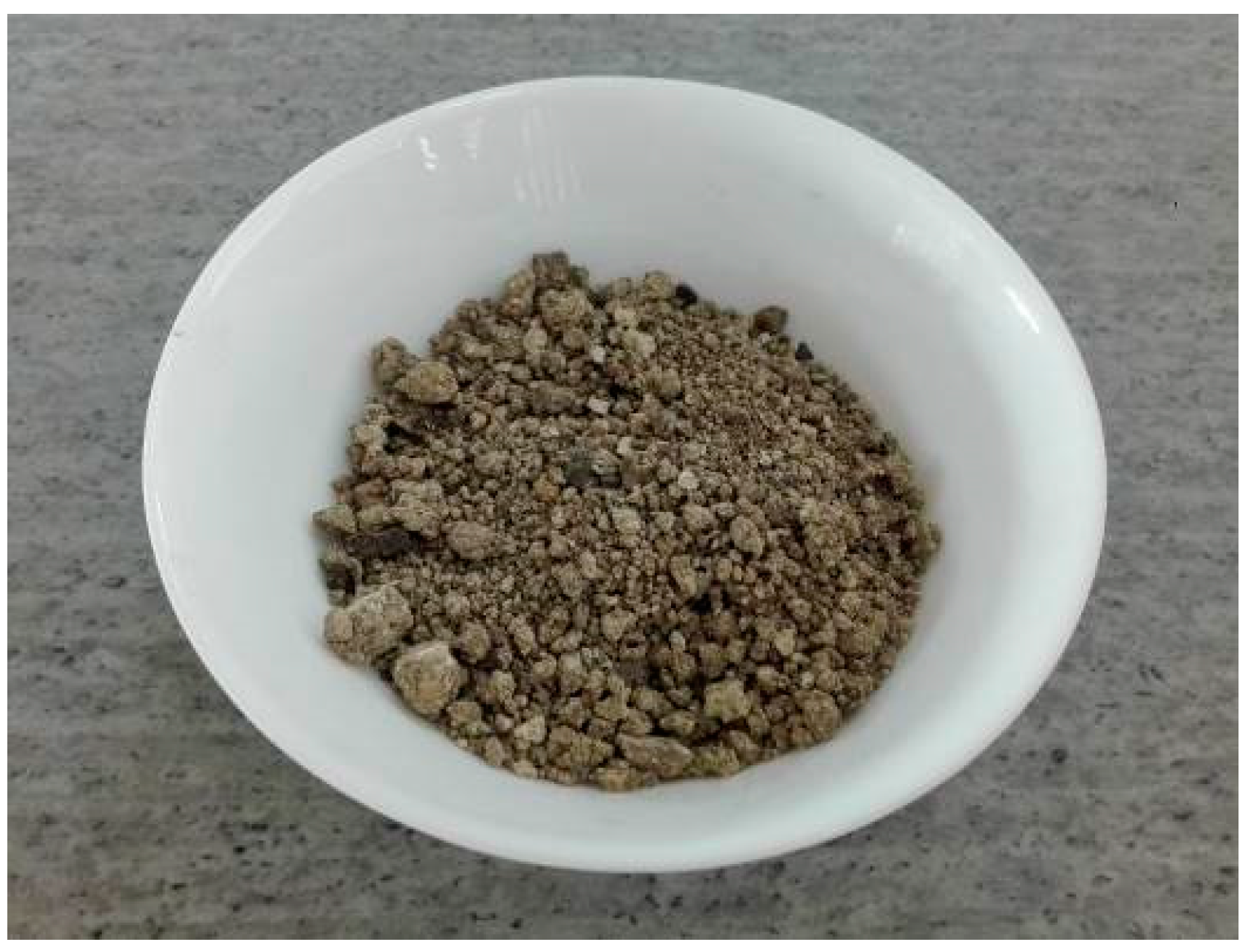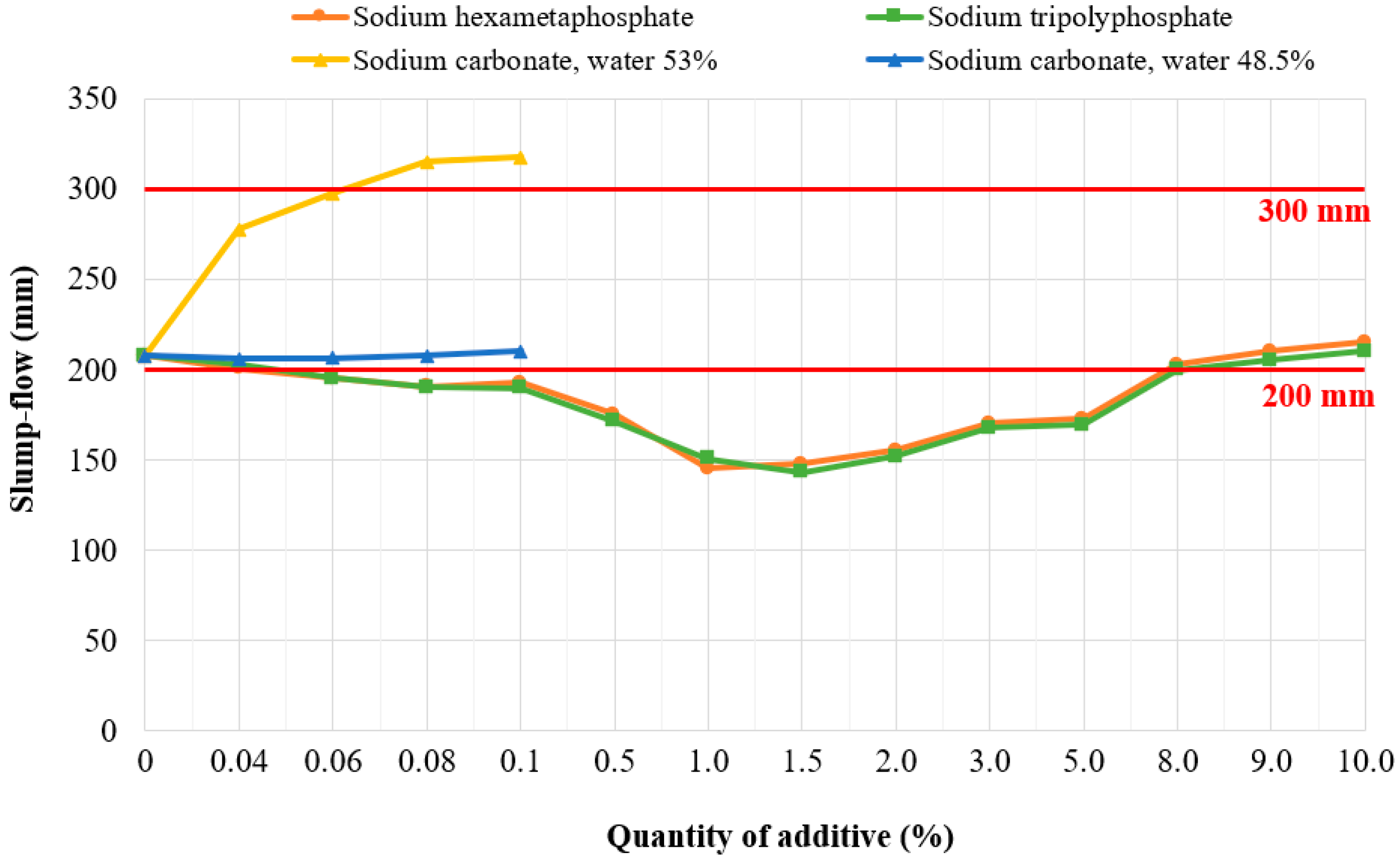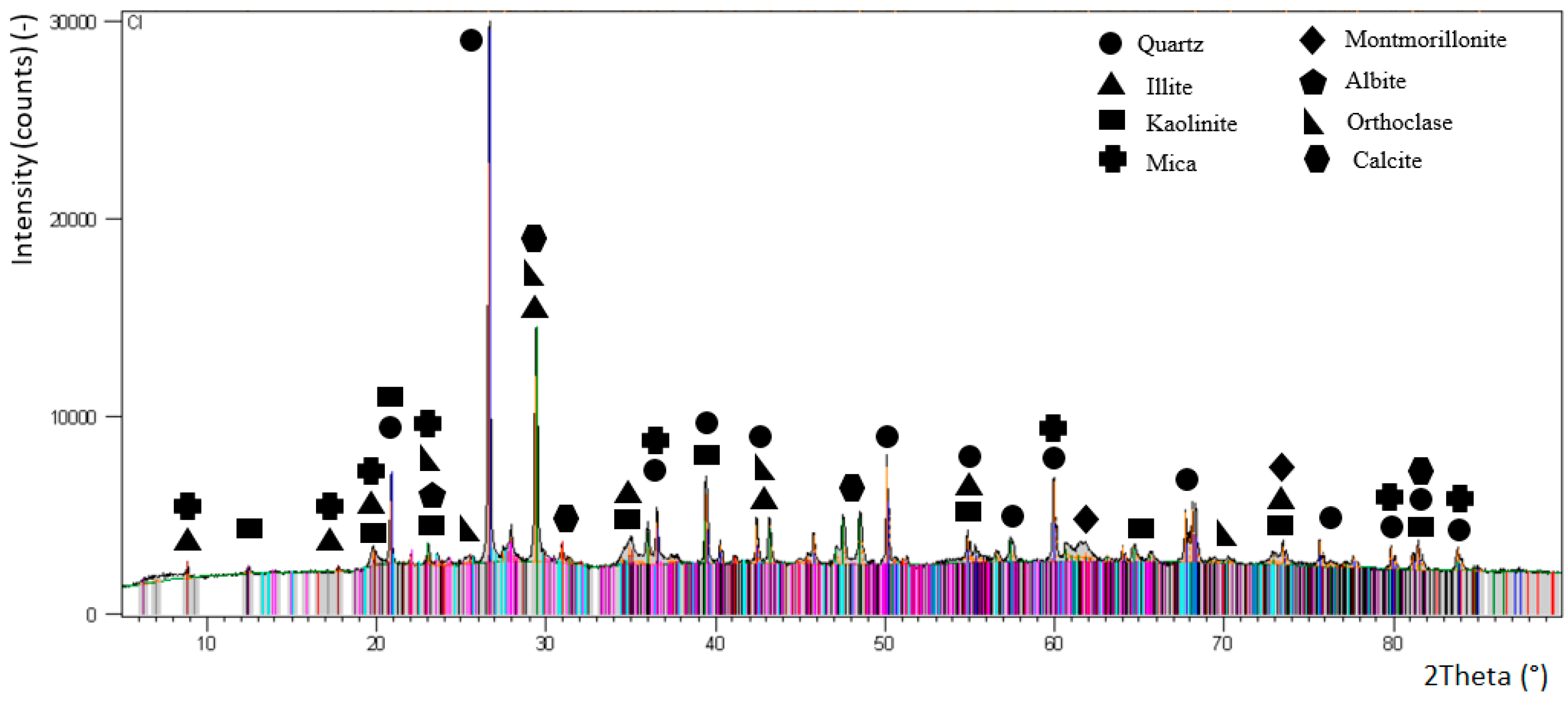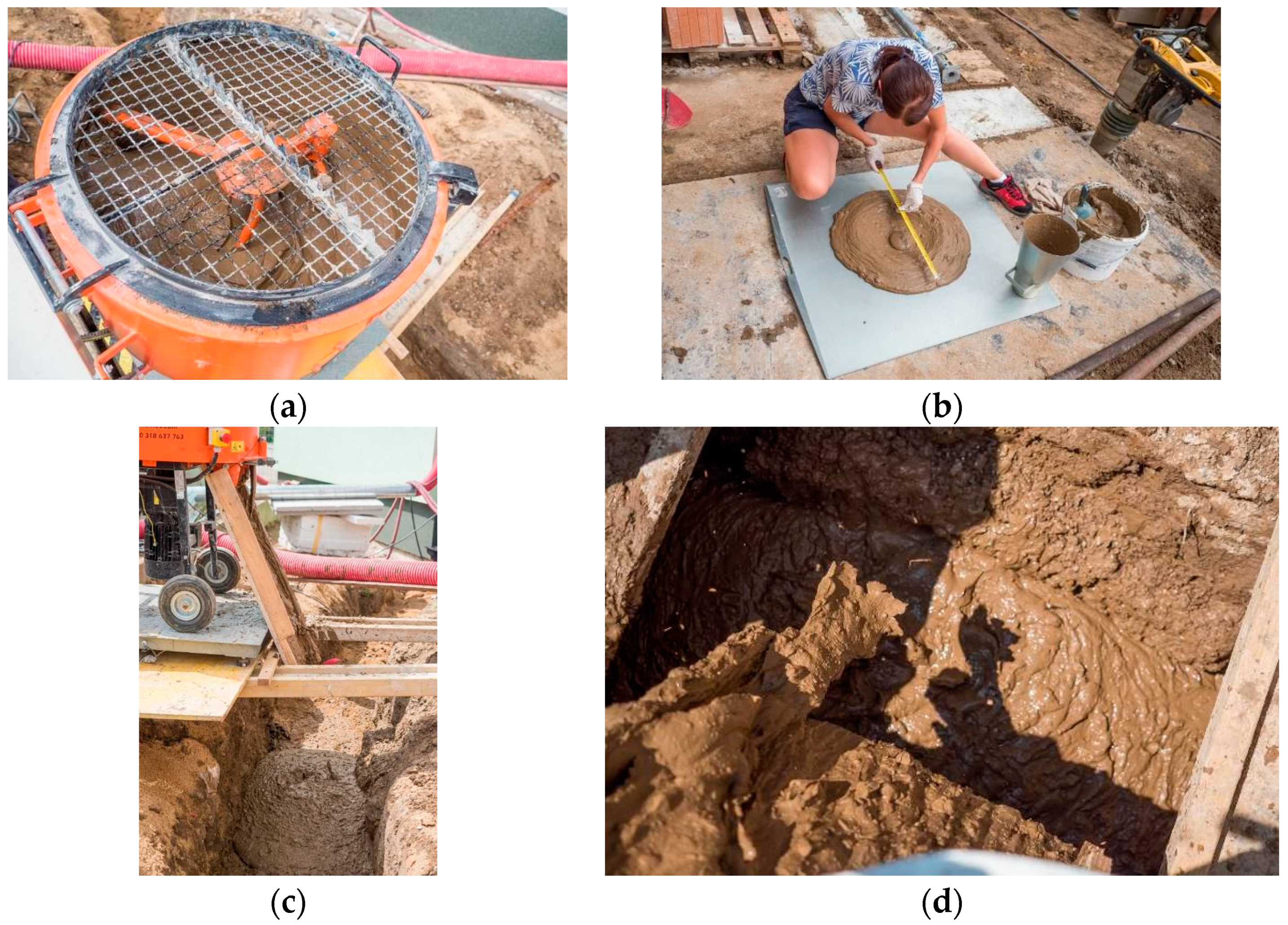Utilization of Fluidized Bed Combustion Fly Ash in the Design of Reuse Clay Soil in the Form of Self-Compacting Grouts
Abstract
:1. Introduction
2. Materials and Methods
3. Results and Discussion
3.1. Physical–Mechanical Parameters
- Clay soil (Cl)-Cl-REF;
- Clay soil (Cl) + 4% CEM II/B-M (S-LL) 32,5 R (CEM)-Cl + 4% CEM;
- Clay soil (Cl) + 0.1% sodium carbonate (SC)-Cl + 0.1% SC’
- Clay soil (Cl) + 10% fluidized bed combustion fly ash (FBCA)-Cl + 10% FBCA;
- Clay soil (Cl) + 10% fluidized bed combustion fly ash (FBCA) + 4% CEM II/B-M (S-LL) 32,5 R (CEM)-Cl + 10% FBCA + 4% CEM;
- Clay soil (Cl) + 10% fluidized bed combustion fly ash (FBCA) + 4% CEM II/B-M (S-LL) 32,5 R (CEM) + 0.1% sodium carbonate (SC)-Cl + 10% FBCA + 4%CEM + 0.1% SC;
- Clay soil (Cl) + 30% fluidized bed combustion fly ash (FBCA)-Cl + 30% FBCA;
- Clay soil (Cl) + 30% fluidized bed combustion fly ash (FBCA) + 4% CEM II/B-M (S-LL) 32,5 R (CEM)-Cl + 30% FBCA + 4% CEM; and
- Clay soil (Cl) + 30% fluidized bed combustion fly ash (FBCA) + 4% CEM II/B-M (S-LL) 32,5 R (CEM) + 0.1% sodium carbonate (SC)-Cl + 30% FBCA + 4%CEM + 0.1% SC.
3.2. Verification of Self-Compacting Grout in Situ
4. Conclusions
- The originality of the research of the article was to find an optimal technology or a new effective method that led to the transformation of clay soil into a self-compacting grout. Due to existing technologies (especially soil compaction), the research works had led to the development of the new and simple technology of self-compacting grouts. In comparison to existing utility excavation technology, it has been shown that these grouts can unequivocally compete with soil compaction due to their excellent properties that meet all standards, and without the need to transport to landfills.
- On the basis of the results obtained, it can be stated that by the appropriate choice of materials it is possible to achieve the treatment of clay soil Cl so that it can be reused in the trench and not transported to landfills.
- Chemical stabilization (achieved by a chemical reaction between the stabilizer/binder and minerals in the soil) and its subsequent liquefaction were used as an optimal treatment of clay soil Cl to achieve self-compacting grout parameters.
- For the chemical stabilization of clay soil Cl, FBCA was used in the amount of 10% and 30% (of the weight of the soil). The use of sodium carbonate in an amount of 0.1% (of the weight of the soil) was chosen as a suitable liquefying agent to achieve the self-compacting effect of the grout.
- It has been experimentally determined that the use of 10% FBCA with clay soil Cl is most suitable for achieving the optimal spillage parameter of self-compacting grout (class SF2 (660–750 mm) and class SF3 (760–850 mm)). For this self-compacting grout containing 10% fluidized fly ash, the highest spillage value of 710 mm (SF2) was achieved at 57% humidity. In assessing the effect of sodium carbonate on the spillage parameter, it has been found that its use is more suitable for self-compacting clay soil Cl-based grouts, which do not contain FBCA.
- In monitoring the effect of sodium carbonate on clay soil Cl, it was found that there was an increase in the electrokinetic potential, thereby reducing the viscosity of the self-compacting grout. Chemically, this reaction resulted in the binding of polyvalent cations on the surface of the micelle of clay minerals. The Na2CO3 sodium carbonate compound in this reaction was able to bind the Ca2+ cations contained in the clay soil and replace them with 2Na+ cations, which resulted in liquefaction of the self-compacting grout (by increasing the spillage value).
- From the point of view of the determination of the compressive strength parameter of self-compacting grouts, it was found, based on thorough laboratory testing, that the presence of FBCA and sodium carbonate in the grout, and also the amount of moisture of the self-compacting grout in the fresh state, have a significant effect on this parameter. To achieve optimum compressive strength value, the use of 10% FBCA and 4% cement with clay soil Cl seems to be suitable. The self-compacting grout thus designed has reached the highest compressive strengths (0.95 MPa after seven days of maturation and 1.35 MPa after 28 days of maturation).
- Based on the achieved spillage and compressive strength values, it can be stated that for the improvement of these parameters, when designing self-compacting clay soil Cl-based grouts, it is recommended to use FBCA in the amount of 10% (of the weight of the soil) in combination with a liquefying additive sodium carbonate in the amount of 0.1% (of the weight of the soil). Within the monitoring of environmental parameters, it should be noted that these parameters were also met when using FBCA in the amount of 30%.
- After verifying the effect of the self-compacting grout in situ, it can be stated that the grout easily flowed around the water installation and showed a self-compacting effect. The grout was therefore easy to pour off without the need for vibration. Due to the presence of cement and FBCA, the grout showed its stability. This phenomenon was observed by the fact that no sedimentation of the particles occurred, and the grout maintained a uniform dispersion of the particles until hardening. The effect of cement and FBCA was also manifested by increasing the load capacity of the grout over time.
Author Contributions
Funding
Acknowledgments
Conflicts of Interest
References
- Gálvez-Martos, J.L.; Styles, D.; Schoenberger, H.; Zeschmar-Lahl, B. Construction and demolition waste best management practice in Europe. Res. Conserv. Recycl. 2018, 136, 166–178. [Google Scholar] [CrossRef] [Green Version]
- Menegaki, M.; Damigos, D. A review on current situation and challenges of construction and demolition waste management. Curr. Opin. Green Sustain. Chem. 2018, 13, 8–15. [Google Scholar] [CrossRef]
- Kůs, L.; Dashöfer, V. ENVI Profi.cz. Possibilities of Treat of Excavated Soil from the Perspective of CEI. Prague: Copyright ©1997–2020 by Dashöfer Holding. Available online: https://www.enviprofi.cz/33/moznosti-nakladani-s-vykopovou-zeminou-z-pohledu-cizp-uniqueidgOkE4NvrWuOKaQDKuox_Z698RJlwPFGUf3llXS_TvYo/ (accessed on 4 April 2020).
- Directive 2008/98/EC of the European Parliament and of the Council of 19 November 2008 on Waste and Repealing Certain Directives: (Text with EEA Relevance). EUR-Lex Access to European Union Law. Official Journal of the European Union: OJ L 312, 22.11.2008, 3–30, 2008, 19 November 2008. Available online: https://eur-lex.europa.eu/eli/dir/2008/98/2018-07-05 (accessed on 15 April 2020).
- EU Circular Economy Action Plan—A new Circular Economy Action Plan for a Cleaner and More Competitive Europe: 2020 Circular Economy Package; European Commission: Brussels, Belgium, 2020.
- Keller Inc. Keller: Improvement of Weak Soils by the Deep Soil Mixing Method. Keller Bronchure. Available online: http://www.keller.co.uk (accessed on 15 January 2020).
- Pašek, J.; Matula, M. Engineering Geology I., II.; Czech Technical Matrix: Prague, Czech Republic, 1995. [Google Scholar]
- Marsh, A.; Heath, A.; Patureau, P.; Evernden, P.; Walker, P. Influence of clay minerals and associated minerals in alkali activation of soils. Constr. Build. Mater. 2019, 229, 116816. [Google Scholar] [CrossRef]
- Makusa, G.P. Soil Stabilization Methods and Materials: In Engineering Practice; Department of Civil, Environmental and Natural resources engineering: Division of Mining and Geotechnical Engineering: Luleå, Sweden, 2012; Available online: http://www.pure.ltu.se/portal/files/42050076/soil_stabilization_methods_and_materials.pdf. (accessed on 21 April 2020).
- Liu, Y.; Chang, C.-W.; Namdar, A.; She, Y.; Lin, C.-H.; Yuan, X.; Yang, Q. Stabilization of expansive soil using cementing material from rice husk ash and calcium carbide residue. Constr. Build. Mater. 2019, 221, 1–11. [Google Scholar] [CrossRef]
- Andavan, S.; Pagadala, V.K. A study on soil stabilization by addition of fly ash and lime. Mater. Today 2020. [Google Scholar] [CrossRef]
- Jha, A.K.; Sivapullaiah, P.V. Physical and strength development in lime treated gypseous soil with fly ash—Micro-analyses. Appl. Clay Sci. 2017, 145, 17–27. [Google Scholar] [CrossRef]
- Sherwood, P. Soil Stabilization with Cement and Lime; State of the Art Review; Transport Research Laboratory, HMSO: London, UK, 1993; ISBN 9780115511714. [Google Scholar]
- Kafodya, I.; Okonta, F. Effects of natural fiber inclusions and pre-compression on the strength properties of lime-fly ash stabilised soil. Constr. Build. Mater 2018, 170, 737–746. [Google Scholar] [CrossRef]
- Ingles, O.; Metcalf, J. Soil Stabilization: Principles and Practice; Butterworths: Sydney, Australia, 1972; p. 374. ISBN 04-094-8215-3. [Google Scholar]
- Zabielska-Adamska, K. Characteristics of Compacted Fly Ash as a Transitional Soil. Materials 2020, 13, 1387. [Google Scholar] [CrossRef] [Green Version]
- Yang, S.; Liu, W. The Effect of Changing Fly Ash Content on the Modulus of Compression of Stabilized Soil. Materials 2019, 12, 2925. [Google Scholar] [CrossRef] [Green Version]
- Andavan, S.; Pagadala, V.K. Experimental study on addition of lime and fly ash for the soil stabilization. Mater. Today 2020, 22, 1065–1069. [Google Scholar] [CrossRef]
- White, D.J.; Harrington, D.S.; Thomas, Z. Fly Ash Soil Stabilization for NonUniform Subgrade Soils. In Engineering Properties and Construction Guidelines 2005, I.; IHRB Project TR-461, FHWA Project 4: Washington, WA, USA, 2005. [Google Scholar]
- Cristelo, N.; Fernández-JiméneZ, A.; Vieira, C.; Miranda, T.; Palomo, Á. Stabilisation of construction and demolition waste with a high fines content using alkali activated fly ash. Constr. Build. Mater. 2018, 170, 26–39. [Google Scholar] [CrossRef]
- Jiang, X.; Huang, Z.; Ma, F.; Luo, X. Analysis of Strength Development and Soil–Water Characteristics of Rice Husk Ash–Lime Stabilized Soft Soil. Materials 2019, 12, 3873. [Google Scholar] [CrossRef] [PubMed] [Green Version]
- Indiramma, P.; Sudharani, C.; Needhidasan, S. Utilization of fly ash and lime to stabilize the expansive soil and to sustain pollution free environment—An experimental study. Mater. Today 2020, 22, 694–700. [Google Scholar] [CrossRef]
- Bao, X.; Jin, Z.; Cui, H.; Chen, X.; Xie, X. Soil liquefaction mitigation in geotechnical engineering: An overview of recently developed methods. Soil Dyn. Earthq. Eng. 2019, 120, 273–291. [Google Scholar] [CrossRef]
- Liquid Soil—A Technical Challenge—UNITRACC—Underground Infrastructure Training and Competence Center. Wiehl, Germany: ©2019 Knowledge Factory GmbH, a Subsidiary of Prof. Dr. Ing. Stein & Partner GmbH. Available online: http://www.unitracc.com/aktuelles/artikel/liquid-soil--a-technical-challengeen (accessed on 2 November 2019).
- Bell, F.G. Ground Engineer’s Reference Book; Butterworths: London, UK, 1987; pp. 38–117. ISBN 978-0408011730. [Google Scholar]
- Chlupáč, I.; Brzobohatý, R.; Kovanda, J.; Stráník, Z. Geological History of the Czech Republic; Academia: Prague, Czech Republic, 2002; ISBN 80-200-0914-0. [Google Scholar]
- European Harmonized Standard EN ISO 14688-1 Geotechnical Investigation and Testing—Identification and Classification of Soil—Part 1: Identification and Description; International Organization for Standardization: Geneva, Switzerland, 2018.
- European Harmonized Standard EN ISO 15688: Road Construction and Maintenance Equipment—Soil Stabilizers—Terminology and Commercial Specifications; International Organization for Standardization: Geneva, Switzerland, 2012.
- European Harmonized Standard EN 1997-2 Eurocode 7: Geotechnical design—Part 2: Ground Investigation and Testing; International Organization for Standardization: Geneva, Switzerland, 2008.
- European Harmonized Standard EN ISO/CD 20500-3 Mobile road Construction Machinery—Safety—Part 3: Specific Requirements for Soil-Stabilising Machines and Recycling Machines; International Organization for Standardization: Geneva, Switzerland, 2020.
- European Harmonized Standard EN ISO 15176: Guidance on Characterization of Excavated Soil and Other Materials Intended for Re-use; International Organization for Standardization: Geneva, Switzerland, 2019.
- European Harmonized Standard EN ISO 15176: Soil Quality—Characterization of Excavated Soil and Other Soil Materials Intended for Re-use, International Organization for Standardization: Geneva, Switzerland, 2002.
- Černý, V.; Keprdová, Š. Usability of fly ashes from Czech Republic for sintered artificial aggregate. In Advances in Materials and Materials Processing IV, Advanced Materials Research; Trans Tech Publications: Zurich, Switzerland, 2014; pp. 805–808. ISBN 978-3-03835-014-9. ISSN 1022-6680. [Google Scholar]
- Němec, F.; Kučerka, D.; Míka, J.; Rubý, P.; Weiss, V. Proposal of Database Structure for Foundation Soil for Civil Engineering Purposes. Procedia Eng. 2016, 161, 422–427. [Google Scholar] [CrossRef] [Green Version]
- Garzón, E.; Cano, M.; O’kelly, B.C.; Sánchez-Soto, P.J. Phyllite clay–cement composites having improved engineering properties and material applications. Appl. Clay Sci. 2015, 114, 229–233. [Google Scholar] [CrossRef] [Green Version]
- Saride, S.; Puppala, A.J.; Chikyala, S.R. Swell-shrink and strength behaviors of lime and cement stabilized expansive organic clays. Appl. Clay Sci. 2013, 85, 39–45. [Google Scholar] [CrossRef]
- Wu, Z.; Deng, Y.; Lui, S.; Lui, Q.; Chen, Y.; Zha, F. Strength and micro-structure evolution of compacted soils modified by admixtures of cement and metakaolin. Appl. Clay Sci. 2016, 127–128, 44–51. [Google Scholar] [CrossRef] [Green Version]
- Yoobanpot, N.; Jamsawang, P.; Horpibulsuk, S. Strength behavior and microstructural characteristics of soft clay stabilized with cement kiln dust and fly ash residue. Appl. Clay Sci. 2017, 141, 146–156. [Google Scholar] [CrossRef]
- Qian, J.; Hu, Y.; Zhang, J.; Xiao, W.; Ling, J. Evaluation the performance of controlled low strength material made of excess excavated soil. J. Clean. Prod. 2019, 214, 79–88. [Google Scholar] [CrossRef]
- Kim, Y.-S.; Do, T.M.; Kim, H.-K.; Kang, G. Utilization of excavated soil in coal ash-based controlled low strength material (CLSM). Constr. Build. Mater. 2016, 124, 598–605. [Google Scholar] [CrossRef]
- Tikalsky, P.; Gaffney, M.; Regan, R. Properties of controlled low-strength material containing foundry sand. ACI Mater. J. 2000, 97, 698–702. [Google Scholar]
- European Harmonized Standard EN 12350-8 Testing Fresh Concrete—Part 8: Self-Compacting Concrete–Slump-Flow Test; International Organization for Standardization: Geneva, Switzerland, 2019.
- European Harmonized Standard EN 12390-3 Testing Hardened Concrete—Part 3: Compressive Strength of Test Sspecimens; International Organization for Standardization: Geneva, Switzerland, 2019.










| Input Material | SiO2 (%) | Al2O3 (%) | Fe2O3 (%) | SO3 (%) | CaO (%) | MgO (%) | K2O (%) | Na2O (%) | P2O5 (%) | Loss on Ignition (%) |
|---|---|---|---|---|---|---|---|---|---|---|
| FBCA | 27.60 | 17.50 | 5.63 | 7.57 | 30.40 | 0.84 | 0.46 | 0.33 | 0.25 | 2.04 |
© 2020 by the authors. Licensee MDPI, Basel, Switzerland. This article is an open access article distributed under the terms and conditions of the Creative Commons Attribution (CC BY) license (http://creativecommons.org/licenses/by/4.0/).
Share and Cite
Drochytka, R.; Michalčíková, M. Utilization of Fluidized Bed Combustion Fly Ash in the Design of Reuse Clay Soil in the Form of Self-Compacting Grouts. Materials 2020, 13, 1972. https://doi.org/10.3390/ma13081972
Drochytka R, Michalčíková M. Utilization of Fluidized Bed Combustion Fly Ash in the Design of Reuse Clay Soil in the Form of Self-Compacting Grouts. Materials. 2020; 13(8):1972. https://doi.org/10.3390/ma13081972
Chicago/Turabian StyleDrochytka, Rostislav, and Magdaléna Michalčíková. 2020. "Utilization of Fluidized Bed Combustion Fly Ash in the Design of Reuse Clay Soil in the Form of Self-Compacting Grouts" Materials 13, no. 8: 1972. https://doi.org/10.3390/ma13081972




